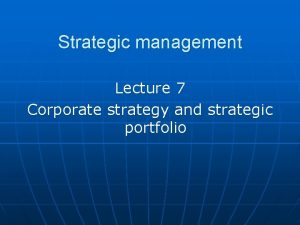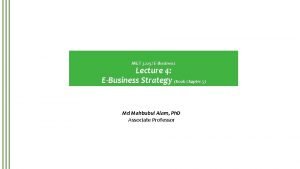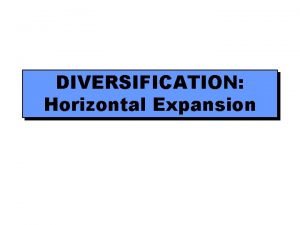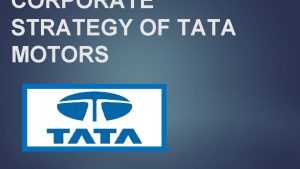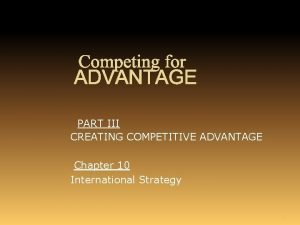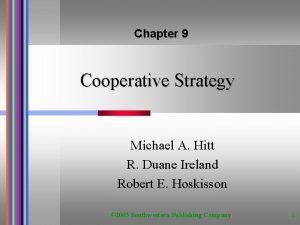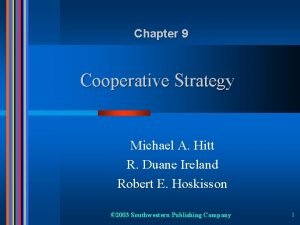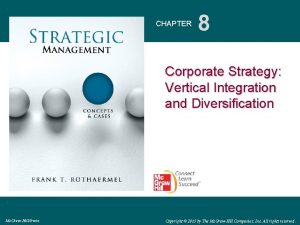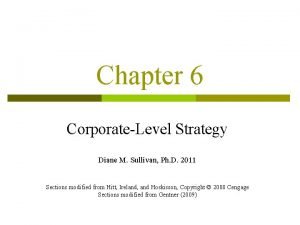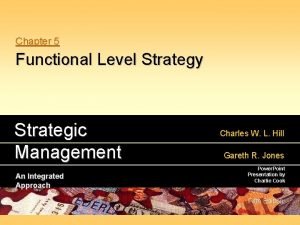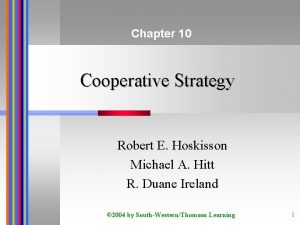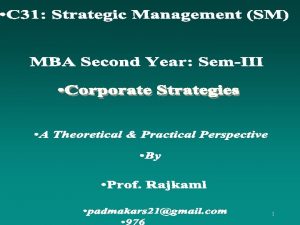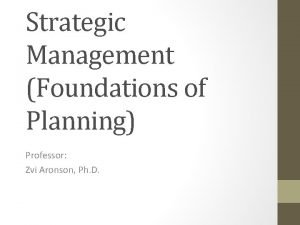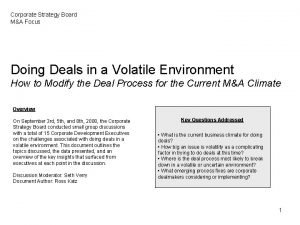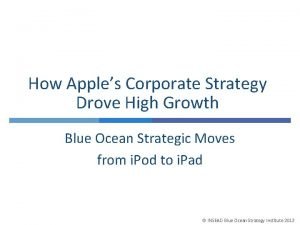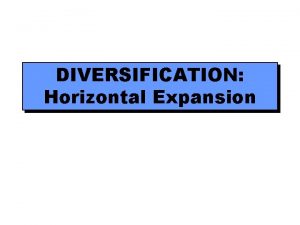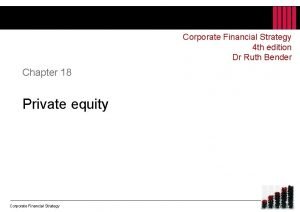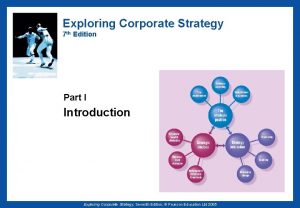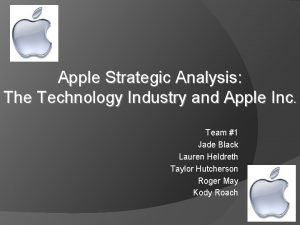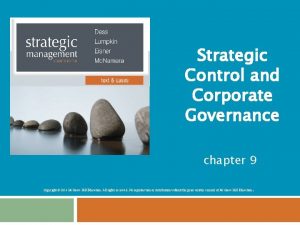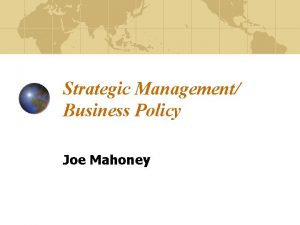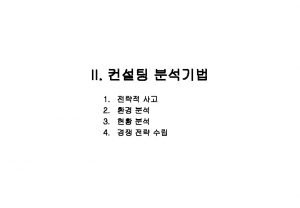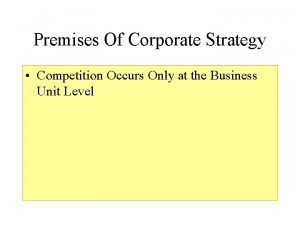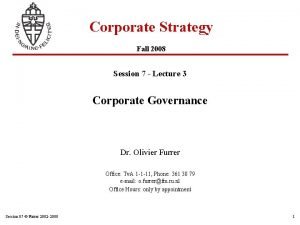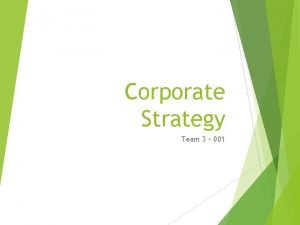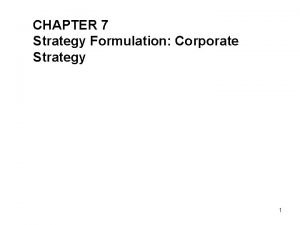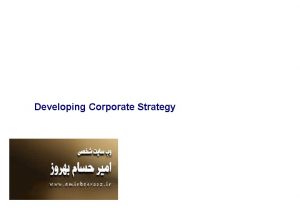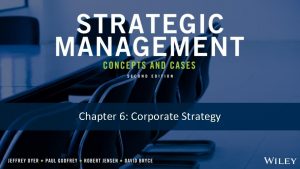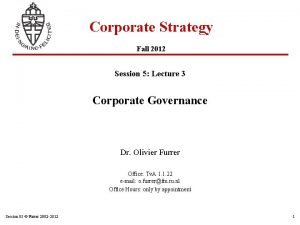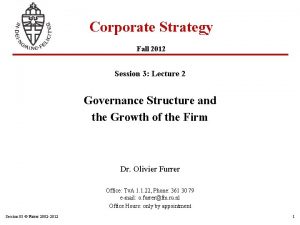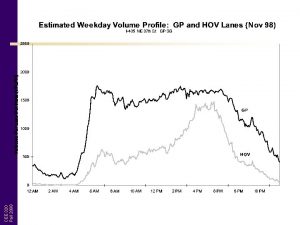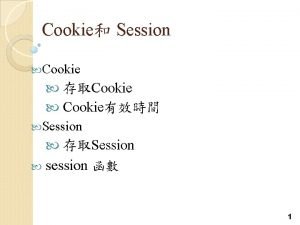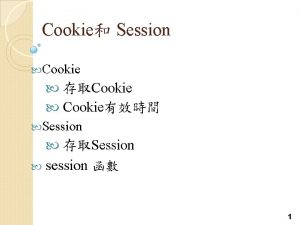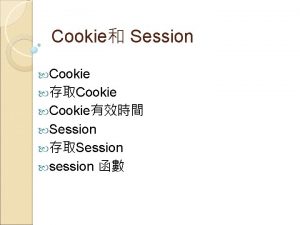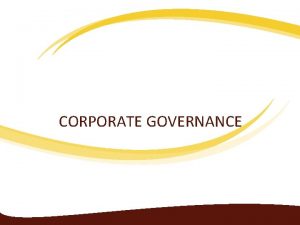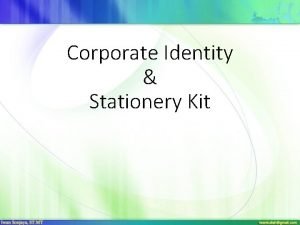Corporate Strategy Fall 2008 Session 11 Corporate Strategy



































- Slides: 35

Corporate Strategy Fall 2008 Session 11 Corporate Strategy: Organizational and International Dimensions Dr. Olivier Furrer Office: Tv. A 1 -1 -11, Phone: 361 30 79 e-mail: o. furrer@fm. ru. nl Office Hours: only by appointment Session 11 © Furrer 2002 -2008 1

Functional Structure Matrix Structure Network Structure Size of Organization Large Simple Structure Multidivisional Structure Coordination and Control Problems Small Young Session 11 © Furrer 2002 -2008 Age of Organization Maturity Ref. : Adapted from Greiner, 1972; Churchill and Lewis, 1983 Strategy and Structure Growth Pattern 2

Functional Structure Chief Executive Officer Finance Production Session 11 © Furrer 2002 -2008 R&D Accounting Sales & Marketing Human Resources 3

Functional Structure Chief Executive Officer Corporate R&D Finance Production Session 11 © Furrer 2002 -2008 Corporate Finance Strategic Planning Engineering Corporate Marketing Accounting Corporate Human Resources Sales & Marketing Human Resources 4

Multi-Divisional Structure Chief Executive Officer Corporate R&D Division Finance Corporate Finance Strategic Planning Division Production Session 11 © Furrer 2002 -2008 Engineering Corporate Marketing Corporate Human Resources Division Accounting Sales & Marketing Division Human Resources 5

Multi-Divisional Structure Three variations of the Multi-Divisional Structure Multi-Divisional Form Strategy Type Cooperative Form Related-Constrained Strategic Business Unit (SBU) Structure Related-Linked Competitive Form Unrelated /Holding Company Session 11 © Furrer 2002 -2008 6

Cooperative Form Multi. Divisional Structure Each division is operated as a separate business Appropriate for related-diversified businesses Key task of corporate managers is exploiting synergies among divisions Managers use a combination of strategic controls and financial controls Managers try to strike a balance between: Competing among divisions for scarce capital resources Creating opportunities for cooperation to develop synergies The goal is to maximize overall firm performance Session 11 © Furrer 2002 -2008 7

Multi-Divisional Structure The decision-making of managers in a Multi. Divisional structure may be: * Centralized or Decentralized * Bureaucratic or Non-bureaucratic Balance on these dimensions may change over time Structure will evolve over time with: * Changes in Strategy * Degree of Diversification * Geographic scope * Nature of competition Session 11 © Furrer 2002 -2008 8

Evolution of Multi-Divisional Structure Chief Executive Officer Corporate Office (Staff) Product A Finance Product B Production Engineering Accounting Sales & Marketing Human Resources 9 Session 11 © Furrer 2002 -2008

Evolution of Multi-Divisional Structure Chief Executive Officer Corporate Office (Staff) Product A Product B North America Finance Europe Production Engineering Session 11 © Furrer 2002 -2008 Product C Product D Asia Accounting Sales & Marketing Human Resources 10

Corporate-Level International Strategies Type of Corporate Strategy selected will have an impact on the selection and implementation of the business-level strategies Some Corporate strategies provide individual country units with flexibility to choose their own strategies Others dictate business-level strategies from the home office and coordinate resource sharing across units Three Corporate Strategies Session 11 © Furrer 2002 -2008 Multi-Domestic Strategy Global Strategy Transnational Strategy 11

Multi-Domestic Strategy and operating decisions are decentralized to strategic business units (SBU) in each country Products and services are tailored to local markets Business units in each country are independent of each other Assumes markets differ by country or regions Focus on competition in each market Prominent strategy among European firms due to broad variety of cultures and markets in Europe Session 11 © Furrer 2002 -2008 12

Global Strategy Products are standardized across national markets Decisions regarding business-level strategies are centralized in the home office Strategic business units (SBU) are assumed to be interdependent Emphasizes economies of scale Often lacks responsiveness to local markets Requires resource sharing and coordination across borders (which also makes it difficult to manage) Session 11 © Furrer 2002 -2008 13

Transnational Strategy Seeks to achieve both global efficiency and local responsiveness Difficult to achieve because of simultaneous requirements for strong central control and coordination to achieve efficiency and local flexibility and decentralization to achieve local market responsiveness Must pursue organizational learning to achieve competitive advantage Session 11 © Furrer 2002 -2008 14

International Corporate Strategy High Global Co-ordination Integration Global Trans. National Multi. National Low Session 11 © Furrer 2002 -2008 National differentiation, Responsiveness High 15

Evolution of Multi-Divisional Structure Chief Executive Officer Corporate Office (Staff) Product A Product B Product C Product D A Structural evolution based on Product lines usually implies a Global International Strategy Session 11 © Furrer 2002 -2008 16

Evolution of Multi-Divisional Structure Chief Executive Officer Corporate Office (Staff) North America Europe Asia Latin America Product A Product B Product C Product D Africa Australia A Structural evolution based on Geographic lines usually implies a Multi-Domestic International Strategy Session 11 © Furrer 2002 -2008 17

Evolution of Multi-Divisional Structure A Transnational International Strategy is likely to utilize a structure and that results in emphasis on both geographic and product structures Session 11 © Furrer 2002 -2008 18

SBU’s Help to Solve Complexity Issues Chief Executive Officer Corporate Office (Staff) Strategic Business Unit A Strategic Business Unit B Division Strategic Business Unit C Strategic Business Unit D Division Strategic Business Units (SBUs) are used to organize related businesses into groups for strategy development Session 11 © Furrer 2002 -2008 19

Global Matrix Structure Chief Executive Officer Corporate Office (Staff) North America Africa Unit 2 Unit 3 Unit 4 Unit 5 Unit 6 Unit 7 Unit 8 Unit 9 Unit 10 Unit 11 Unit 12 Europe Asia Product A Unit 1 Product B Product C Session 11 © Furrer 2002 -2008 20

Traditional International Structures Worldwide Product Division FOREIGN PRODUCT DIVERSITY International Division Global Matrix Area Division FOREIGN SALES AS PERCENTAGE OF TOTAL SALES Session 11 © Furrer 2002 -2008 21

Multi-Divisional Structure The choice between centralization and decentralization is frequently based on the business-level strategy implemented in each division Differentiation Decentralization Cost Leadership Complex Multi-Divisional structure firms may be simultaneously centralized and decentralized , depending upon the various business-level strategies employed throughout the firm’s individual businesses Multi-Divisional structure firms use a combination of: Strategic Controls Session 11 © Furrer 2002 -2008 Financial Controls 22

Attributes of Various Structural Forms Structural Characteristics Cooperative M-Form SBU M-Form Competitive M-Form Type of Strategy Related. Constrained Mixed Related or Unrelated Degree of Centralized at Centralization Corporate Office in SBUs Decentralized to Division Use of Integrating Mechanisms Extensive Synergies Moderate Synergies Nonexistent Synergies Divisional Performance Appraisal Subjective/ Strategic Criteria Strategic & Financial Criteria Divisional Incentive Compensation Session 11 © Furrer 2002 -2008 Linked to Corporate Corporation, Divisional Performance Division & SBU Performance 23

Administrative Heritage Strategic Asset and Organisational Anchor • “Where to” is influenced by “where from. ” • Competitive advantage shaped by country of origin, time of expansion, and nature of leadership. • The challenge is to built new capabilities while protecting existing strengths. Session 11 © Furrer 2002 -2008 24

Pre-war European Empires Nationally Responsive Strategies • Expended abroad in a period of high international barriers. – Preferential access to foreign empire markets • Organisation developed as a portfolio of national companies. – Heritage of family management, personal control • Strategy based on understanding and responding to national markets. Session 11 © Furrer 2002 -2008 25

Pre-War European Empires: Decentralised Federations • MULTINATIONAL STRATEGY MODEL - COMPETE BY BEING NATIONALLY RESPONSIVE Session 11 © Furrer 2002 -2008 26

Post-war American Hegemony Strategy of Knowledge Transfer • Expended abroad in a time of economic reconstruction. – Large, advanced home market as knowledge source • Organisation built on strong links to the parent company based on transfer of expertise. – Heritage of professional management, systems control • Strategy based on transferring parent company’s leadership in technology, marketing, and another skills. Session 11 © Furrer 2002 -2008 27

Post-war American Hegemony: Co-ordinated Federations • INTERNATIONAL STRATEGY MODEL - COMPETE THROUGH KNOWLEDGE TRANSFER Session 11 © Furrer 2002 -2008 28

Modern Day Japanese Challenge Competing Through Global Efficiency • Expanded abroad in a period of falling trade barriers. – Newly added capacity and government industrial policy as assets • Organisation grew as dependent foreign units tightly controlled from the centre. – Heritage of culturally dependent management practices dominated by group processes • Strategy based on capturing global scale economies. Session 11 © Furrer 2002 -2008 29

Modern Day Japanese Challenge: Centralised Hubs • GLOBAL STRATEGY MODEL - COMPETE THROUGH GLOBAL EFFICIENCY Session 11 © Furrer 2002 -2008 30

Strategic Capabilities of the Transnational The New Game for the 21 th Century • Sensitivity, flexibility, and responsiveness to local needs. • Global scale efficiency and competitive response capability. • World-wide innovation skills and learning capabilities. Session 11 © Furrer 2002 -2008 31

The Transnational Organization Model: The Integrated Network Decentralized Federation Centralized Hub The Integrated Network Session 11 © Furrer 2002 -2008 Coordinated Federation 32

Organisational Characteristics of the Transnational • Multi-dimensional Perspective – Large flows of components, products, resources, people, and information among interdependent units. • Distributed, Interdependent Capabilities • Flexible Integrative Process – Complex process of co-ordination and co-operation in an environment of shared decision making Session 11 © Furrer 2002 -2008 33

Organizational Characteristics of the Transnational Session 11 © Furrer 2002 -2008 34

Next Session: Case Study 3 The Globalization of CEMEX Session 11 © Furrer 2002 -2008 35
 2008 2008
2008 2008 Corporate strategy and business strategy
Corporate strategy and business strategy Captive company strategy
Captive company strategy Corporate finance objectives
Corporate finance objectives Types of corporate level strategy
Types of corporate level strategy What is corporate strategy in strategic management
What is corporate strategy in strategic management Business vs corporate strategy
Business vs corporate strategy Corporate scope
Corporate scope Hr-strategy map
Hr-strategy map 5 dimensions of diversification
5 dimensions of diversification Business strategy of tata motors
Business strategy of tata motors Corporate strategy triangle
Corporate strategy triangle A multidomestic corporate-level strategy is one in which:
A multidomestic corporate-level strategy is one in which: Corporate level cooperative strategy
Corporate level cooperative strategy Corporate level cooperative strategy
Corporate level cooperative strategy Three dimensions of corporate strategy
Three dimensions of corporate strategy Corporate level strategy types
Corporate level strategy types Business-level strategy
Business-level strategy Functional level strategy in strategic management
Functional level strategy in strategic management Corporate level cooperative strategy
Corporate level cooperative strategy Formulating corporate level strategy
Formulating corporate level strategy Types of corporate level strategy
Types of corporate level strategy Zvi aronson
Zvi aronson Corporate strategy board
Corporate strategy board Apple blue ocean strategy
Apple blue ocean strategy Three dimensions of corporate strategy
Three dimensions of corporate strategy Corporate financial strategy
Corporate financial strategy Three dimensions of corporate strategy
Three dimensions of corporate strategy Nintendo bcg matrix
Nintendo bcg matrix Strategy 7 corporation
Strategy 7 corporation Industry analysis of apple
Industry analysis of apple Writing a strategy
Writing a strategy Strategic control and corporate governance
Strategic control and corporate governance A transnational corporate-level strategy seeks to achieve
A transnational corporate-level strategy seeks to achieve Elements of strategic thinking
Elements of strategic thinking Multipoint competition occurs when
Multipoint competition occurs when





